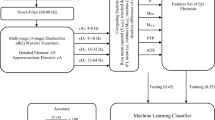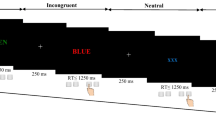Abstract
Spatial working memory has been extensively investigated with different tasks, treatments, and analysis tools. Several studies suggest that low frequency of the repetitive transcranial magnetic stimulation (rTMS) applied to the parietal cortex may influence spatial working memory (SWM). However, it is not yet known if after low-frequency rTMS applied to the superior parietal cortex, according to Pz electroencephalography (EEG) electrode, would change the orientation interpretation about the vertical and horizontal axes coordinates in an SWM task. The current study aims at filling this gap and obtains a better understanding of the low-frequency rTMS effect in SWM. In this crossover study, we select 20 healthy subjects in two conditions (control and 1-Hz rTMS). The subjects performed an SWM task with two random coordinates. Our results presented that low-frequency rTMS applied over the superior parietal cortex may influence the SWM to lead to a larger distance of axes interception point (p < 0.05). We conclude that low-frequency rTMS over the superior parietal cortex (SPC) changes the SWM performance, and it has more predominance in horizontal axis.




Similar content being viewed by others
References
Vergauwe E, Cowan N (2014) A common short-term memory retrieval rate may describe many cognitive procedures. Front Hum Neurosci 8:126
Luck SJ, Vogel EK (1997) The capacity of visual working memory for features and conjunctions. Nature 390(6657):279–281. https://doi.org/10.1038/36846
Nelson Cowan J, Saults S, Blume CL (2014) Central and peripheral components of working memory storage. J Exp Psychol Gen 143(5):1806–1836. https://doi.org/10.1037/a0036814
Federico F, Delogu F, Raffone A (2014) Maintenance and manipulation of object sequences in working memory: a lifespan study. Neurol Sci 35(12):1883–1887. https://doi.org/10.1007/s10072-014-1851-0
O’Reilly JX, Schüffelgen U, Cuell SF, Behrens TE, Mars RB, Rushworth MF (2013) Dissociable effects of surprise and model update in parietal and anterior cingulate cortex. Proc Natl Acad Sci U S A 110(38):E3660–E3669. https://doi.org/10.1073/pnas.1305373110
Üstün S, Kale EH, Çiçek M (2017) Neural networks for time perception and working memory. Front Hum Neurosci 11:83
Koenigs M, Acheson DJ, Barbey AK, Solomon J, Postle BR, Grafman J (2011) Areas of left perisylvian cortex mediate auditory-verbal short-term memory. Neuropsychologia 49(13):3612–3619. https://doi.org/10.1016/j.neuropsychologia.2011.09.013
Pennick MR, Kana RK (2012) Specialization and integration of brain responses to object recognition and location detection. Brain Behav 2(1):6–14. https://doi.org/10.1002/brb3.27
Koenigs M, Barbey AK, Postle BR, Grafman J (2009) Superior parietal cortex is critical for the manipulation of information in working memory. J Neurosci 29(47):14980–14986. https://doi.org/10.1523/JNEUROSCI.3706-09.2009
Pinto Y, van der Leij AR, Sligte IG, Lamme VA, Scholte HS (2013) Bottom-up and top-down attention are independent. J Vis 13(3):16. https://doi.org/10.1167/13.3.16
Parks EL, Madden DJ (2013) Brain connectivity and visual attention. Brain Connect 3(4):317–338. https://doi.org/10.1089/brain.2012.0139
Garcea FE, Mahon BZ (2014) Parcellation of left parietal tool representations by functional connectivity. Neuropsychologia 60:131–143
Herwig U, Satrapi P, Schönfeldt-Lecuona C (2003) Using the international 10-20 EEG system for positioning of transcranial magnetic stimulation. Brain Topogr 16(2):95–99. https://doi.org/10.1023/B:BRAT.0000006333.93597.9d
Postle BR, Ferrarelli F, Hamidi M, Feredoes E, Massimini M, Peterson M, Alexander A, Tononi G (2006) Repetitive transcranial magnetic stimulation dissociates working memory manipulation from retention functions in the prefrontal, but not posterior parietal, cortex. J Cogn Neurosci 18(10):1712–1722. https://doi.org/10.1162/jocn.2006.18.10.1712
Oldfield RC (1971) The assessment and analysis of handedness: the Edinburgh inventory. Neuropsychologia 9(1):97–113. https://doi.org/10.1016/0028-3932(71)90067-4
Kehrer S, Kraft A, Koch SP, Kathmann N, Irlbacher K, Brandt SA (2015) Timing of spatial priming within the fronto-parietal attention network: a TMS study. Neuropsychologia 74:30–36. https://doi.org/10.1016/j.neuropsychologia.2014.11.017
Rossi S, Hallett M, Rossini PM, Pascual-Leone A (2011) Screening questionnaire before TMS: an update. Clin Neurophysiol 122(8):1686. https://doi.org/10.1016/j.clinph.2010.12.037
Humphreys GF, Lambon Ralph MA (2015) Fusion and fission of cognitive functions in the human parietal cortex. Cereb Cortex 25(10):3547–3560
Wager TD, Smith EE (2003) Neuroimaging studies of working memory: a meta-analysis. Cogn Affect Behav Neurosci 3(4):255–274. https://doi.org/10.3758/CABN.3.4.255
Duecker F, Sack AT (2015) Rethinking the role of sham TMS. Front Psychol 6:210
Gongora M, Bittencourt J, Teixeira S, Basile LF, Pompeu F, Droguett EL, Arias-Carrion O, Budde H, Cagy M, Velasques B, Nardi AE, Ribeiro P (2016) Low-frequency rTMS over the parieto-frontal network during a sensorimotor task: the role of absolute beta power in the sensorimotor integration. Neurosci Lett 611:1–5. https://doi.org/10.1016/j.neulet.2015.11.025
Najib U, Bashir S, Edwards D, Rotenberg A, Pascual-Leone A (2011) Transcranial brain stimulation: clinical applications and future directions. Neurosurg Clin N Am 22(2):233–251, ix. https://doi.org/10.1016/j.nec.2011.01.002
Rossi S, Hallett M, Rossini PM, Pascual-Leone A, Safety of TMS Consensus Group (2009) Safety, ethical considerations, and application guidelines for the use of transcranial magnetic stimulation in clinical practice and research. Clin Neurophysiol 120(12):2008–2039. https://doi.org/10.1016/j.clinph.2009.08.016
Vandenberghe R, Gitelman DR, Parrish TB, Mesulam MM (2001) Location- or feature-based targeting of peripheral attention. NeuroImage 14(1 Pt 1):37–47. https://doi.org/10.1006/nimg.2001.0790
Oliveira FT, Diedrichsen J, Verstynen T, Duque J, Ivry RB (2010) Transcranial magnetic stimulation of posterior parietal cortex affects decisions of hand choice. Proc Natl Acad Sci U S A 107(41):17751–17756. https://doi.org/10.1073/pnas.1006223107
Hopkins WG, Marshall SW, Batterham AM, Hanin J (2009) Progressive statistics for studies in sports medicine and exercise science. Med Sci Sports Exerc 41(1):3–13. https://doi.org/10.1249/MSS.0b013e31818cb278
Fayers PM, Machin D (1995) Sample size: how many patients are necessary? Br J Cancer 72(1):1–9. https://doi.org/10.1038/bjc.1995.268
Fougnie D, Marois R (2011) What limits working memory capacity? Evidence for modality-specific sources to the simultaneous storage of visual and auditory arrays. J Exp Psychol Learn Mem Cogn 37(6):1329–1341. https://doi.org/10.1037/a0024834
Murray AM, Nobre AC, Stokes MG (2011) Markers of preparatory attention predict visual short-term memory performance. Neuropsychologia 49(6):1458–1465. https://doi.org/10.1016/j.neuropsychologia.2011.02.016
Proctor RW, Cho YS (2006) Polarity correspondence: a general principle for performance of speeded binary classification tasks. Psychol Bull 132(3):416–442. https://doi.org/10.1037/0033-2909.132.3.416
Neiman T, Loewenstein Y (2014) Spatial generalization in operant learning: lessons from professional basketball. PLoS Comput Biol 10(5):e1003623. https://doi.org/10.1371/journal.pcbi.1003623
Kaminski JA, Korb FM, Villringer A, Ott DV (2011) Transcranial magnetic stimulation intensities in cognitive paradigms. PLoS One 6(9):e24836. https://doi.org/10.1371/journal.pone.0024836
Treister R, Lang M, Klein MM, Oaklander AL (2013) Non-invasive transcranial magnetic stimulation (TMS) of the motor cortex for neuropathic pain—at the tipping point? Rambam Maimonides Med J 4(4):e0023
Author information
Authors and Affiliations
Corresponding author
Ethics declarations
Participants signed the free and informed consent term. The protocol was approved by the ethics committee of Federal University of Rio de Janeiro (no. 520.189).
Conflict of interest
The authors declare that they have no conflict of interest.
Rights and permissions
About this article
Cite this article
Ribeiro, J.A., Marinho, F.V.C., Rocha, K. et al. Low-frequency rTMS in the superior parietal cortex affects the working memory in horizontal axis during the spatial task performance. Neurol Sci 39, 527–532 (2018). https://doi.org/10.1007/s10072-017-3243-8
Received:
Accepted:
Published:
Issue Date:
DOI: https://doi.org/10.1007/s10072-017-3243-8




